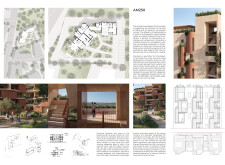5 key facts about this project
## Project Overview
The AM250 design project is located in close proximity to the port of Olbia, aiming to integrate modern residential living with a strong acknowledgment of its geographical context. The residential complex is designed to fulfill both functional and aesthetic requirements, resulting in a nuanced relationship between built form and its environmental setting.
### Conceptual Framework
The architectural approach is informed by the characteristics of port containers, conveying themes of international exchange. The façade consists of orthogonally superimposed cubes that reflect the visual language of shipping containers and create a dialogue with the existing commercial landscape of Olbia. Terracotta is utilized as a primary cladding material, establishing a connection with regional architectural traditions while emphasizing sustainability.
### Design Elements and Materiality
- **Materials**: The project prominently features terracotta for façade cladding and roofing, reflecting local heritage while modernizing traditional applications. Concrete serves as the structural backbone, ensuring durability against coastal conditions, while wood is incorporated in elements such as railings and decorative details, adding warmth to the overall design.
- **Architectural Features**: The façade's rhythmic composition of cubes, varying in size and orientation, maximizes natural light and creates dynamic shadow play throughout the day. This design encourages passive solar strategies, enhancing energy efficiency. Landscaping utilizes native plants to promote biodiversity and minimize water requirements, while shared green spaces function for both aesthetic enjoyment and ecological benefit. Common gathering areas, including a rooftop terrace, facilitate social interaction among residents, underscoring the project's emphasis on community engagement.
Key aspects of the AM250 project focus on fostering individual comfort alongside communal experiences, with deliberate spatial planning that cultivates interaction and a sense of belonging. Additionally, the design incorporates strategies for enhancing outdoor comfort, contributing to a sustainable microclimate. Each design element is carefully calibrated to respond to the local environment, utilizing appropriate materials and considering climate challenges to achieve visual coherence and ecological sustainability.



















































